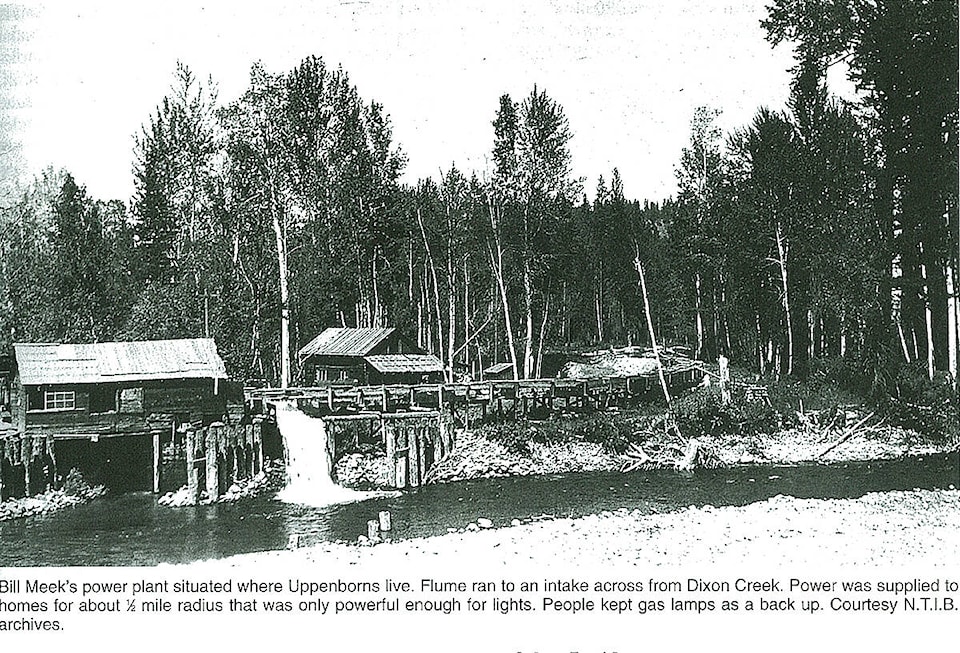This story ran on Barriere’s 100th anniversary in 2014, coordinating with February 1, 1914, when the first post office in Barriere was officially opened.
The narrow Barriere River valley runs east-west, sheltered from the north winds, with the hills rising steeply from the North Thompson Valley floor.
The first people to utilize the valley left almost no mark upon the land as they migrated with the seasons, foraging for plants and berries to supplement their diets, and hunting and fishing.
Among the first peoples in the area were those from the Simpcw First Nation. The Simpcw are a division of the Secwepemc, or Shuswap, whose traditional territory encompasses approximately 5,000,000 Ha in the North Thompson region. The area extends from slightly North of McLure to the headwaters of Fraser River near McBride, to Tête Jeune Cache, over to Jasper and south to the headwaters of the Athabasca River. Archaeological studies have identified winter home sites and underground food cache sites at a variety of locations in the area, including Chu Chua, Barriere River, and Louis Creek.
In the summer months, much of their time was spent in hunting camps in the mountains above the North Thompson. The river systems provided salmon, which were caught in weirs, nets and by spear. Numerous plant foods were also collected and preserved for winter use. There was active trading, and sometimes warfare with the Sekani and Cree people.
Hardy adventurers almost certainly explored the route for the fur trade, and they were followed by an influx of people from eastern Canada or the U.S.A., and from across the Atlantic. These people arrived hoping to realize the dream of owning their own plot of land.
However, only a few would stay and put down roots. Many returned to their homelands to help fight a long and bitter WWI.
For those settlers who stayed to work the land they obtained through pre-emption and hoped to farm there was much hard work ahead. Much of the land in the valley is hilly, the soil sandy, rocky or in other places heavy clay. Often water is scarce, or would have been impossible to move to where it was needed by the methods of the time. Early pioneers worked diligently to clear the land, often planting around the stumps of trees and rock piles.
In the History of the Northwest Coast, H.H. Bancroft says that two French Canadian gold seekers panned for gold in 1857 in the river they named “the Barriere”. Gilbert Genier, Arthur Sanborn and others were engaged in logging the flats (commonly known as the Sanborn flats) around the Barriere river near the turn of the 20th century.
In 1905, James A. Sheilds, owner of large sawmills in the Kamloops area, and surveyor T.L. Bloomer, bought and sold several large lots in the area. The greater part of the flats as well as bench land to the north was bought up by 1921 by the Barriere Land Company, a subsidiary of British American Trust.
It was surveyed into mostly 10-acre lots with a view to large profits when these would be sold for intensive agriculture. The late Manne Salle, and a resident of Barriere today, recalls the whole area being slashed and burned back then to prepare for this venture.
In the BC Directory of 1917, Gilbert Genier is listed as operating a store and hotel. This building, which was also the Genier home, and was situated on the flat east of Leonie (Gordon) Creek not far from the Barriere River. The first telephone system up the North Thompson was operating in the Genier hotel in 1910.
By 1913 James Nelson was operating a large sawmill on the North Thompson riverbank to the south side of the Barriere River. By the time the railway was in service in 1916, he had closed his mill operation and built a hotel across the tracks, using lumber from the mill.
The years between the two wars marked a new drive to acquire land. In the East Barriere valley, development accelerated with the building of a power plant on the Barriere River which supplied Kamloops with economical electricity.
Opened in 1914, it provided employment for a number of men until it closed in the early 1950s. In the early years, the station was operating only in the warmest months of the year.
It was not operable after freeze-up because the water in the flume and pipes froze. The system initially consisted of a wooden timber division dam that diverted the water from the Barriere River into a wooden flume and pipe, a concrete forebay, steel penstocks and reinforced concrete powerhouse with two turbines. This was considered prudent for the time, with upgrading taking place as needed.
The first school, the Barriere Valley School, opened at the Forts in 1914, then the Barriere Powerhouse School in 1916, later renamed Floral Creek School in the 1920s.
In 1915 the CNR passenger service started.
This helped Archdeacon Stephen Akehurst (Anglican Church) get from one end of the North Thompson Valley to the other. He visited everyone in the valley, no matter what denomination they were. If people were busy, he just pitched in to help.
He rode in a two-wheel sulky behind his bay horse, other times he rode on its back, at other times he walked many miles. For 20 years the Archdeacon devoted his time and energy to missionary work in Barriere and the North Thompson Valley.
This article was compiled using excerpts from the book ‘Exploring Our Roots, NorthThompson Valley McLure to Little Fort 1763-1959’, as well as other documents of historical reference.
